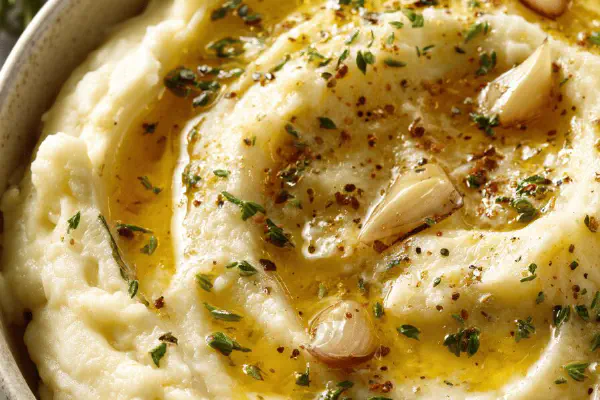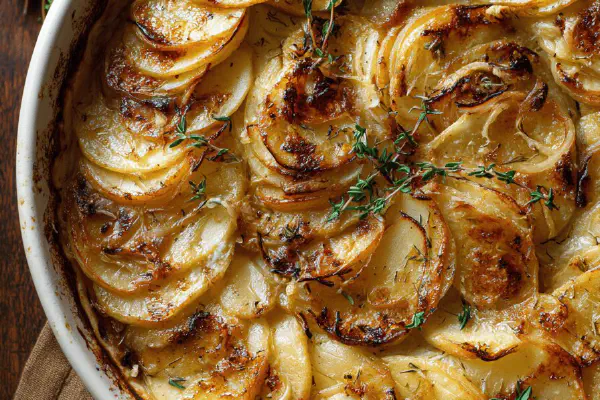Twisted Garlic Mash

By Emma
Certified Culinary Professional
Ingredients
- 900 g (about 6 cups) red potatoes peeled and cubed
- 6 shallots peeled
- 80 g (about 1/3 cup) extra virgin olive oil
- 150 ml (2/3 cup) heavy cream, warmed
- 1 litre vegetable stock
- Salt and freshly ground black pepper
- Optional: drizzle of browned olive oil or small herb butter cubes at serving
About the ingredients
Method
- Pour vegetable stock in heavy saucepan with shallots. Bring to gentle boil. Add potatoes and lower heat to maintain soft simmer. Watch bubbles, not furious boil. Cook 30–35 minutes. Test doneness by poking a cube with fork — slides in with little resistance is your signal. Shallots should be soft, almost melting.
- Drain potatoes and shallots together, keep a small ladle of cooking liquid just in case. Toss everything back in pan, off heat. Begin mashing with sturdy masher or ricer if you want finesse, I usually mash by hand to keep some texture. Add olive oil slowly, mixing well to incorporate and emulsify. It changes texture, adds silky richness.
- Now warm cream, pour a splash at a time into mash while stirring actively. Watch for fluffiness, not soup. If too dry, add tiny drops of reserved stock. Salt midway and taste often; always adjust at finish. Black pepper also here, grinding fresh over the top brings freshness.
- Serve immediately in warm bowls, top with a spoonful of browned olive oil or herbed butter cubes to melt and add aroma. The shallots give a subtle sweetness and depth. Texture should be creamy but not gummy. If overworked or liquid added fast, mash turns gluey. Patience pays off.
- Leftovers reheat with splash of cream or stock on low, stirring often. Avoid microwave overheat to keep integrity. Could add roasted garlic for another layer, but here shallots take center stage for a twist.
Cooking tips
Chef's notes
- 💡 Slow simmer is king here. Don’t rush boil or potatoes shred. Watch bubbles for gentle movement. Soft simmer lets shallots break down, release subtle sweetness. Fork poke near silent glide signals readiness. Leave skins on if feeling rustic but cube smaller. More bite, less fluff but adds heart.
- 💡 Mash off heat keeps residual warmth doing softening work. Using ricer adds silk but hand mash preserves chunks, texture alive. Add olive oil slow, stirring constantly. It shifts mouthfeel, adds depth without heaviness. Cream warm, add splash by splash—if you rush liquid, mash turns gluey. Controlled moisture.
- 💡 Stock over plain water means salt carefulness. Taste mid-mash before final salt. Stock adds background seasoning already. Pepper last, freshly cracked to keep bite sharp. Adding browned olive oil or tiny butter cubes last—aroma thickens bowl, scent wakes senses. Skip premature seasoning, always test.
- 💡 Reheating tricky. Heat low, stir often with splash cream or stock. Microwave burns, dries quickly. Leftovers soften with gentle warming only. Roasted shallots swap okay if shy on sweetness layer. Garlic optional but clashes with shallot focus. Keep flavors clean but layered. Heat control prevents curdling dairy.
- 💡 Avoid lumps by gradual liquid addition and vigorous mashing. Don’t dump all stock or cream at once. Patience pays off with texture that glistens but not wet. Visual cue: skins peeling after boil means starches ready. Aromas scents shifting during cooking used as timing guide. Season like a pro: test continuously.
Common questions
Can I use Yukon Gold instead?
Sure, Yukon Gold melts different, creamier but less texture. Red potatoes give waxy, chunkier feel. If Yukon Gold, reduce liquid, mash gentler. Flavor changes; shallots still key. Adjust timing for softness.
What if mash turns gluey?
Usually too much liquid or overmashing. Fix with less dairy added fast, add reserved stock slowly. Use ricer for silk or hand tools for chunk. Mash tighter can become glue. Heat off helps. Stir gently after liquids.
Can I substitute vegetable stock?
Water works but flavor flattens out. Chicken stock adds richness but shifts profile from subtle herb notes. Homemade stock preferred. Store-bought often too salty; taste as you go with salt. Low salt stock safest.
How to store leftovers?
Cool fast, airtight container fridge up to 3 days. Reheat low temp stirring regularly, add splash cream or stock. Freeze okay but loses texture, best fresh. Add butter or olive oil on reheat for richness, not too hot. Microwave risk of dryness or splitting cream.



